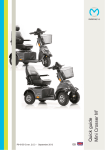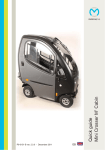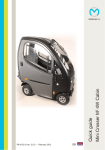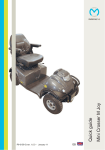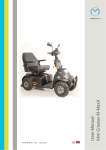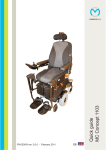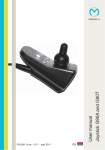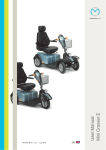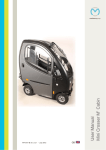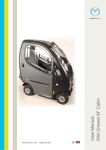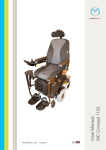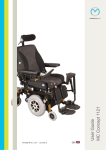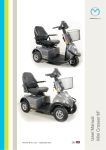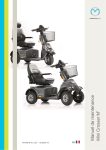Download Medema Mini Crosser M-MaxX User manual
Transcript
Quick guide Mini Crosser M-MaxX medemagroup P9-0135-Q ver. 1.0.0 - April 2012 GB Medema Production A/S Quick guide P9-0135-Q 2 of 20 Version 1.0.0/2012 Medema Production A/S Contents Quick guide to the Mini Crosser M-MaxX ............................................... 4 Introduction................................................................................................ 4 Control panel ............................................................................................. 5 Seat rotation............................................................................................... 7 Steering column ........................................................................................ 8 Charging ..................................................................................................... 9 Battery indicator ...................................................................................... 10 General care and maintenance .............................................................. 13 Insurance.................................................................................................. 14 Serial number........................................................................................... 15 Driving the Mini Crosser M-MaxX ......................................................... 15 Getting in and out ................................................................................. 15 When driving in traffic... ........................................................................ 17 Electromagnetic compatibility ............................................................... 17 Braking systems ...................................................................................... 18 Anti-tilt wheels / stabilisers .................................................................... 19 Quick guide P9-0135-Q 3 of 20 Version 1.0.0/2012 Medema Production A/S Quick guide to the Mini Crosser M-MaxX Introduction Congratulations on your new Mini Crosser M-MaxX electric mobility scooter. You have now taken possession of an electric mobility scooter developed for outdoor driving by active users. It is what is called a Class C vehicle in accordance with the European classification of electric scooters. For optimum enjoyment of this vehicle - and to avoid breakdowns and accidents - we recommend that you read the User Manual carefully. As a new user, you should pay particular attention to the section entitled “Driving the Mini Crosser M-MaxX”. Note: This Quick Guide is to be regarded as a supplement to the User Manual. The information in the Quick Guide cannot, therefore, be expected to be complete. NB: Errors and omissions excepted. Specifications subject to change. We reserve the right to update this guide as required. Warning! The Mini Crosser M-MaxX is a powerful vehicle, equipped with 2 motors. One on each rear wheel. Therefore, careful training on the use of the vehicle is required. The vehicle must not be lent to persons who are not completely familiar with it. The vehicle is designed for one person only. Max. user weight 250 kg. Medema Production A/S is not responsible for any damage or injuries caused by inappropriate or unsafe use of the Mini Crosser. Quick guide P9-0135-Q 4 of 20 Version 1.0.0/2012 Medema Production A/S Control panel Avoid subjecting the control panel to jarring and knocks. Take care when driving and avoid hitting obstacles. Hazard warning lights Light switch Speed selector High/low switch Indicator lights, R/L Indicator lights, R/L Horn Horn Accelerator (four-finger control) Lever for adjusting the angle of the handlebars Charging socket Battery indicator Key switch Quick guide P9-0135-Q 5 of 20 Version 1.0.0/2012 Medema Production A/S Designation Description Key switch To start the vehicle: Turn the key to driving position (1) When the Mini Crosser is turned on, the control system performs a safety check of the electrical system. The check lasts half a second. If the accelerator is operated during this time, the Mini Crosser will not be able to move until you have turned the key to 0 and back to 1. Speed selector The tortoise in minimum position indicates the lowest speed range. 0-6 km/h The hare in maximum position indicates the highest speed range. Up to 11.5 km/h Battery indicator Lights up when the key is turned. After approximately 1 second, indicates the batteries’ charge level. Provides a more accurate indication after a few minutes driving. This is not an exact measurement and you must therefore build up some experience with it. In the same way as the petrol gauge on a car. When the red light is farthest from “1”, there is plenty of power in the batteries. When the red light is farthest from “0” and flashing, it is close to being completely discharged. Accelerator Activate the arm at the front slowly and the Mini Crosser will start to move forwards. The more the arm is pressed, the faster the Mini Crosser will move. When the arm is released, it will flip back to starting position of its own accord and the Mini Crosser will stop. Activating the rear arm will cause the Mini Crosser to reverse. The magnetic brake on the rear wheels will engage when the scooter is stationary and is equivalent to the parking brake on a car. The accelerator can also be used to control speed downhill. In this case the motor will act as a brake. Light switch Turns on the front and rear lights. The key switch must be in position 1 (driving position). Hazard warning lights Turns on all the indicator lights at once. Also works when the key is removed or turned to position 0 (stop position). Indicator switch Left arrow: indicator, left-hand side. Right arrow: indicator, righthand side. Activate the same switch to turn the indicators off. Horn Powerful electric horn. Press the horn switch to activate. Charging socket Turn off the key switch during charging. Please note that it is not possible to drive the scooter while the batteries are charging. See also the section entitled “Batteries and charging”. High/low switch Switch between high and low max speed. Quick guide P9-0135-Q 6 of 20 Version 1.0.0/2012 Medema Production A/S Seat rotation Pull the release lever back. The seat can be rotated 90° to either side. When the lever is released, it engages with the seat and holds it in place at 45° intervals. Other seats that can be supplied for the Mini Crosser work on similar principles. The release lever is normally located on the right, but can be put on the left if so wished. Release lever for seat rotation. Quick guide P9-0135-Q Release lever for seat forward/back. 7 of 20 Version 1.0.0/2012 Medema Production A/S Steering column Can be adjusted forward/back with the release lever. Pull down on the lever and pull the handlebars closer for a good driving position. Use the lever again and push the steering column forward to make it easier to get out. The height of the steering column can be adjusted approx. 11 cm up/down. First remove the rubber plug covering the Allen screw. Adjust the height using a 4 mm Allen key. Adjusting the height of the handlebars. Lever for adjusting the angle of the handlebars Adjusting the height of the handlebars. Allen screw for height adjustment Quick guide P9-0135-Q 8 of 20 Version 1.0.0/2012 Medema Production A/S Charging The Mini Crosser should be charged while not in use. The charger supplied from the factory switches to trickle charging (very low power consumption) automatically when the batteries are fully charged. You can therefore leave the charger connected until the Mini Crosser is next used. The charger cannot overcharge the batteries. The charger will flash until charging is complete. Then it will show a steady light. IMPORTANT! The charger must not be placed on the seat during charging. IMPORTANT! Never use charging devices other than those supplied from the factory without first contacting the dealer. For further information see the User Manual. NEUTRIK NC3MX charging plug Quick guide P9-0135-Q Connect the charging plug to the 3-pin socket on the steering column. The charging socket is located under the protective cover. 9 of 20 Version 1.0.0/2012 Medema Production A/S Battery indicator The table below indicates the fault types which the battery indicator can display in the case of an electronic fault on the Mini Crosser. Count these and read off in the table what kind of fault they indicate. However, it is recommended that you can quote the number of the flash code when contacting the supplier. LED CODE PROGRAMMING LCD DISPLAY EXPLANATION POSSIBLE CAUSE 1,1 HARDWARE FAILSAFE 2 Loss of power 1. Short circuit in motor or motor cable 2. Failure of control unit HARDWARE FAILSAFE 4 Overcurrent fault HARDWARE FAILSAFE 1 EEPROM fault 1. Fault in or failure of EEPROM HARDWARE FAILSAFE 3 Main contactor fault 1. Main contactor welded 2. Fault in driver in main contactor 3. Fault in coil in main contactor PRECHARGE FAULT Precharge fault 1. Fault in internal control unit 2. Low battery voltage HW FAILSAFE Motor voltage fault 1. Motor voltage does not fulfil throttle requirements. 2. M1 or M2 power shortcircuited to B- or B+. 3. Internal motor short circuit. 4. Failure of control unit SRO SRO fault 1. Wrong sequence of KSI, power activation and input data for direction 2. Selection of wrong SRO type 3. Direction switch circuit open 1,2 2,1 Quick guide P9-0135-Q 1. Short circuit in motor or motor cable 2. Failure of control unit 10 of 20 Version 1.0.0/2012 Medema Production A/S LED CODE PROGRAMMING LCD DISPLAY EXPLANATION POSSIBLE CAUSE 2,2 HPD HPD fault 1. Wrong sequence of KSI, power activation and input data for throttle 2. Wrongly set potentiometer for throttle 2,3 PROC/WIRING FAULT HPD fault displayed for >5 sec. 1. Wrongly set throttle 2. Potentiometer for throttle defective 3. Throttle mechanism defective 2,4 SPD LIMIT POT FAULT Fault in speed limit potentiometer 1. Wiper cable for speed limit potentiometer defective 2. Speed limit potentiometer defective 3,1 BB WIRING CHECK Fault in emergency return cable 1. BB cable open 2. BB check cable open 3,2 EM BRAKE DRVR FAULT Driver fault in electromag. brake 1. Coil on electromagnetic brake short-circuited or open 2. Cable for electromagnetic brake open 3,3 THROTTLE FAULT 1 Fault in throttle 1. Input wire for throttle open 2. Short circuit of input wire for throttle til B+ or B3. Defectective throttle potentiometer 4. Wrong choice of throttle type 4,1 LOW BATTERY VOLTAGE Low battery voltage 1. Battery voltage <16 V (24V models), <21V (36V-models) or <27V (48V-models) 2. Corroded or loose battery clamp 3. Loose clamp on control unit 4,2 OVERVOLTAGE Overvoltage 1. Battery voltage >36 V (24V models), >48V (36V-models) or >60V (48V-models) 2. Vehicle in use with charger connected Quick guide P9-0135-Q 11 of 20 Version 1.0.0/2012 Medema Production A/S LED CODE PROGRAMMING LCD DISPLAY EXPLANATION POSSIBLE CAUSE 4,3 THERMAL CUTBACK Over/undertemperature cutback 1. Temperature >95 ºC or <-25 ºC 2. Overload on vehicle 3. Wrong installation of control unit 4. Operation under extreme conditions Example 1: Fault 1,1 means that the battery indicator flashes as follows: “flash” short pause “Flash” long pause Example 2: Fault 1,2 means that the battery indicator flashes as follows: “flash” short pause “Flash” “Flash” long pause. Quick guide P9-0135-Q 12 of 20 Version 1.0.0/2012 Medema Production A/S General care and maintenance A Mini Crosser M-MaxX does not require much maintenance. It should be kept in a generally good condition, however. The following should be checked regularly: • • • • Tyre pressure (if pneumatic tyres are fitted) Tyre wear Keep the control panel, the charging socket and the electronics box under the seat dry. Battery charging Never wash the Mini Crosser with a high-pressure cleaner or direct water jet! This could damage the Mini Crosser’s electronics. To keep the Mini Crosser in good condition safety-wise, we recommend the following regular checks: Daily: • Test the indicators and driving lights before using the Mini Crosser in the dark or poor visibility. Every three months: • Test the brakes and motor disengagement With the disengagement lever up, it must not be possible to push the Mini Crosser. • Test the brake disengagement function When the brake disengagement lever is up, the battery indicator should flash to show an error if the Mini Crosser is turned on. In this case the Mini Crosser must not be able to move when the accelerator is activated. • • Test the electrical release mechanism. Test that the Mini Crosser can be pushed when the electrical release button is held. When the button is released, it can no longer be pushed. Lubricate the lever arm on the brake hub with acid-free oil - left-hand rear wheel. Quick guide P9-0135-Q 13 of 20 Version 1.0.0/2012 Medema Production A/S Annual The Mini Crosser M-MaxX is designed for safe travel for at least 10 years, up to a max. of 5,000 hours, provided it is serviced and safety-checked every year, corresponding to 500 hours of operation. The service must be carried out by an authorised workshop. IMPORTANT! For safety reasons it is of the utmost importance that the servicing and safety check intervals are complied with, as this minimises the risk of brake failure and short-circuits in the wiring, which could generate heat and cause a fire. (For further information see the Service Manual.) Insurance In the eyes of the law a Mini Crosser M-MaxX with a maximum speed of 11.5 km/h is a cycle, so separate insurance is not required. Most contents/home insurance policies include third-party liability insurance for cyclists and so also cover Mini Crosser M-MaxX users. We recommend that you talk to your insurance company about this when the vehicle is delivered. If necessary, comprehensive insurance will have to be taken out separately. Quick guide P9-0135-Q 14 of 20 Version 1.0.0/2012 Medema Production A/S Serial number All vehicles have a serial number plate showing the year of production, month and serial number. The same serial number can also be found on page two of the User Manual. Please quote the serial number when making inquiries about servicing, spare parts, etc. Driving the Mini Crosser M-MaxX Getting in and out It is important to learn a safe technique for getting in and out of the Mini Crosser. In general the following method should be followed: • • • • • Make sure that the Mini Crosser M-MaxX is off (switch turned to 0) when getting in and out, otherwise the Mini Crosser could start if the accelerator was touched inadvertently. Make sure that the brake is on. (Lever for disengaging motor in down position.) Put the steering column in vertical position. If necessary, turn the seat through 45° or 90° and make sure that it is locked in position (clicked into place). If necessary, raise the armrest. IMPORTANT! The Mini Crosser will turn itself off automatically after it has been stationary for 10 minutes even if the key has been turned to driving position. To restart the vehicle, the key must be turned to stop position (0) and then to drive position (1). Quick guide P9-0135-Q 15 of 20 Version 1.0.0/2012 Medema Production A/S General safety advice: • Make sure that the backrest is upright and the seat is as low as possible. • Positioning belts are recommended if the user is unable to maintain a good driving posture independently. • Adjust your driving to road conditions. Take account of light, traffic and weather. Be particularly careful when driving in the dark or in bad weather, such as rain or snow. Avoid driving on gradients with poor surfaces, such as: snow, ice, newmown grass, wet grass and wet leaves. • Never drive when under the influence. This applies not only to alcohol but also to drugs and medicines. • Reduce speed immediately if you feel you are losing control. • Always use the indicators when changing direction. • Check that lights and indicators are working before driving off. Use your lights when driving after lighting-up time. • As far as possible, grip the handlebars firmly with both hands. Take care not to have anything in the basket at the front that might inadvertently operate the accelerator. WARNING! Do not lower the handlebars so far that the accelerator can hit you on the leg when you turn the vehicle and so be operated in advertently. If the handlebars need to be very low, a twist grip accelerator is recommended. This is particularly relevant if leg supports are being used. ALWAYS switch the scooter off when it is not in use. Turn the key to 0. Note! Do not drive the Mini Crosser when intoxicated. This applies to both medicine and alcohol. Quick guide P9-0135-Q 16 of 20 Version 1.0.0/2012 Medema Production A/S When driving in traffic... Be particularly aware of the following when driving in traffic: • The Mini Crosser is a low vehicle and not always easy for other road users to see. Make quite sure that other road users have seen you before driving onto the highway. • Keep an eye on traffic behind you. Keep well over to the side of the road when driving on busy roads. • Turning right and left at crossroads. Be aware of cyclists and pedestrians. Follow the rules of the road for cyclists. • How quickly things are happening. How long do the lights stay green? How quickly are cars approaching? etc. Electromagnetic compatibility If the Mini Crosser starts making involuntary movements or if the brakes are released, turn the Mini Crosser off as soon as it is safe to do so. In certain circumstances a Mini Crosser can set off shop alarms. The Mini Crosser satisfies the requirements for the use of scooters in an environment with electromagnetic noise. There may, however, be rare situations in which electromagnetic noise can affect the Mini Crosser. Sources of such noise include radio and television stations, amateur radio transmitters and mobile phones. If such equipment is being used close by, it is recommended that the Mini Crosser is switched off. Mobile phones should not be used while driving. Quick guide P9-0135-Q 17 of 20 Version 1.0.0/2012 Medema Production A/S Braking systems There are two braking systems on the Mini Crosser: • Motor brake - adjusts vehicle speed also when going downhill. • Magnetic brake - the magnetic brake is automatic and engages when the Mini Crosser stops. In an emergency, the Mini Crosser can be stopped instantaneously by turning the key switch. Please note that this will cause very sharp braking. The rear wheels will lock. Must NOT be used in the normal course of driving. The brake must never be disengaged mechanically using the disengagement lever on a slope. This function is only designed for use when pushing the Mini Crosser on a flat road. Quick guide P9-0135-Q 18 of 20 Version 1.0.0/2012 Medema Production A/S Anti-tilt wheels / stabilisers The Mini Crosser is a very stable vehicle. HOWEVER, in the case of incorrect weight distribution or careless driving there is a risk of tipping over. We therefore recommend fitting anti-tilt wheels in such circumstances. (See picture below) (Anti-tilt wheels / stabilisers are optional extras.) Anti-tilt wheels Quick guide P9-0135-Q 19 of 20 Version 1.0.0/2012 medemagroup




















